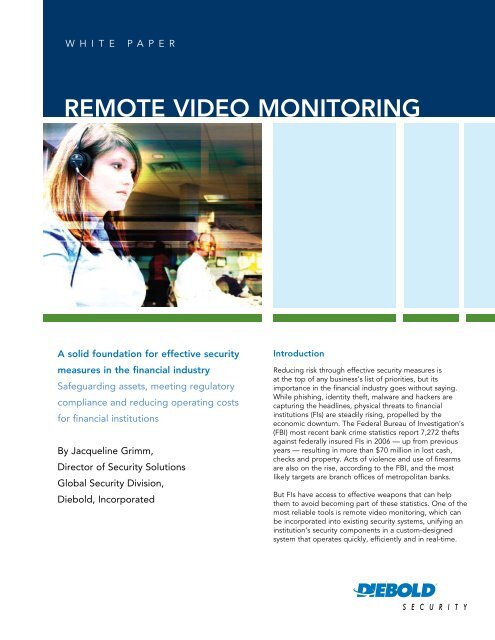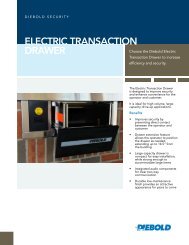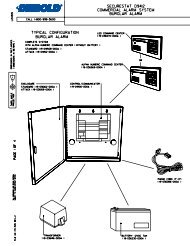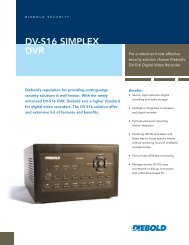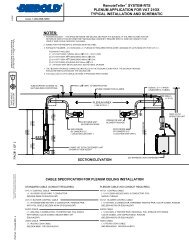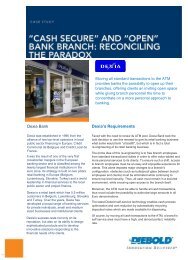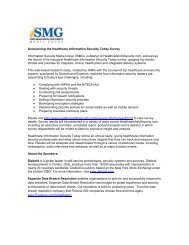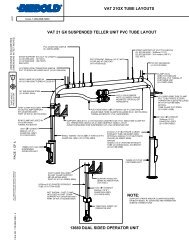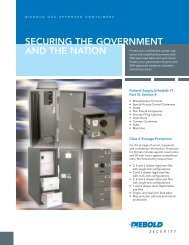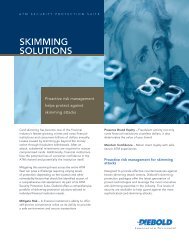Remote video monitoring - Diebold
Remote video monitoring - Diebold
Remote video monitoring - Diebold
Create successful ePaper yourself
Turn your PDF publications into a flip-book with our unique Google optimized e-Paper software.
WhITe PAPeR<br />
<strong>Remote</strong> <strong>video</strong> monitoRing<br />
A solid foundation for effective security<br />
measures in the financial industry<br />
Safeguarding assets, meeting regulatory<br />
compliance and reducing operating costs<br />
for financial institutions<br />
By Jacqueline Grimm,<br />
Director of Security Solutions<br />
Global Security Division,<br />
<strong>Diebold</strong>, Incorporated<br />
introduction<br />
Reducing risk through effective security measures is<br />
at the top of any business’s list of priorities, but its<br />
importance in the financial industry goes without saying.<br />
While phishing, identity theft, malware and hackers are<br />
capturing the headlines, physical threats to financial<br />
institutions (FIs) are steadily rising, propelled by the<br />
economic downturn. The Federal Bureau of Investigation’s<br />
(FBI) most recent bank crime statistics report 7,272 thefts<br />
against federally insured FIs in 2006 — up from previous<br />
years — resulting in more than $70 million in lost cash,<br />
checks and property. Acts of violence and use of firearms<br />
are also on the rise, according to the FBI, and the most<br />
likely targets are branch offices of metropolitan banks.<br />
But FIs have access to effective weapons that can help<br />
them to avoid becoming part of these statistics. One of the<br />
most reliable tools is remote <strong>video</strong> <strong>monitoring</strong>, which can<br />
be incorporated into existing security systems, unifying an<br />
institution’s security components in a custom-designed<br />
system that operates quickly, efficiently and in real-time.
2<br />
The financial industry must remain diligent in employing<br />
the most effective security tactics available.<br />
<strong>Remote</strong> <strong>video</strong> <strong>monitoring</strong> is even more valuable<br />
because of the changing criminal profile. In a struggling<br />
economy, desperate, ordinary citizens are committing<br />
burglaries, robberies and larceny, competing with<br />
seasoned veterans who traditionally orchestrate<br />
and carry out planned assaults. This shift has made<br />
identifying potential criminals a moving target. As part<br />
of this shift, the nature of crimes against FIs has become<br />
opportunistic and spontaneous, according to a 2007<br />
U.S. Department of Justice study. The study identified<br />
three factors contributing to rising robbery rates,<br />
including the increased numbers of branches and<br />
banking outlets offering longer hours, the belief that<br />
FIs are a lucrative target, and the perception that<br />
robberies are quick, low-risk crimes. The FBI reports<br />
that crimes against FIs also are changing geographically,<br />
with increasing numbers of violent crimes taking place<br />
in rural areas, with community branches as targets.<br />
Considering these shifting influences, the financial<br />
industry must remain diligent in employing the most<br />
effective security tactics available. This white paper<br />
explores the security challenges facing today’s financial<br />
industry and focuses on how remote <strong>video</strong> <strong>monitoring</strong><br />
can play a vital role in helping financial professionals<br />
safeguard assets and comply with regulatory mandates,<br />
while also realizing operational efficiencies.<br />
the need for Proactive Security measures<br />
The threat of burglary, robbery, larceny, fraud, money<br />
laundering, and a host of other crimes at FIs is constant.<br />
While an FI certainly needs to protect its assets and<br />
investments, the FBI reports that more than 25 percent<br />
of physical security breaches also involve a firearm or<br />
other weapon. This means an FI is also responsible<br />
for protecting the safety and security of its customers<br />
and employees. Furthermore, a financial institution<br />
depends on its intangible reputation to protect and<br />
secure customer assets; security breaches can negatively<br />
impact an FI’s image within the community and<br />
amongst customers.<br />
FIs must therefore implement proactive security<br />
technologies to help protect their assets, people<br />
and reputation. By effectively <strong>monitoring</strong> activities<br />
24/7 and in real-time and capturing vital <strong>video</strong> and<br />
audio surveillance, FIs can create a proactive, integrated<br />
security system that protects their most important<br />
investments.<br />
How <strong>Remote</strong> <strong>video</strong> <strong>monitoring</strong> Can Help<br />
One of the many benefits of remote <strong>video</strong> <strong>monitoring</strong><br />
is that it can make use of existing security equipment<br />
in a new and more effective fashion, helping FIs to<br />
leverage existing security investments. This also helps<br />
institutions meet self-imposed profitability metrics and<br />
apply a powerful, more integrated approach to their<br />
current security systems.<br />
With remote <strong>video</strong> <strong>monitoring</strong>, FIs can tie their most<br />
essential security components together through cameras<br />
and alarm triggers that can be positioned virtually<br />
anywhere and cued to communicate with a central<br />
<strong>monitoring</strong> station. Providing high-level security for vital<br />
areas, ranging from access control to off-site ATMs to<br />
processing centers <strong>monitoring</strong>, remote <strong>video</strong> <strong>monitoring</strong><br />
embodies one of the financial industry’s most effective,<br />
new security technologies.<br />
What is remote <strong>video</strong> <strong>monitoring</strong>?<br />
<strong>Remote</strong> <strong>video</strong> <strong>monitoring</strong> takes <strong>video</strong> surveillance<br />
a giant step forward. It is composed of two-way,<br />
interactive audio technology that combines existing<br />
DVR technology and <strong>video</strong> surveillance systems with<br />
<strong>monitoring</strong> processes to provide real-time voice and<br />
<strong>video</strong> images to a central <strong>monitoring</strong> station for alarm<br />
verification and action.<br />
With an Underwriter’s Laboratories required reaction<br />
time of 45 seconds or better, central station dispatchers<br />
can quickly and remotely view and monitor a site when<br />
an alarm is triggered and communicate with anyone<br />
on-site. In an event-driven situation, dispatchers can<br />
send out assistance if the event is a detectable situation<br />
or prevent a false dispatch if no security breach has<br />
occurred. Once a situation is diagnosed, the dispatcher<br />
responds using a customized response plan that has<br />
been designed to meet the unique <strong>monitoring</strong><br />
requirements of each FI location.<br />
How <strong>video</strong> <strong>monitoring</strong> works<br />
No matter what the facility — a branch, off-site ATMs,<br />
check processing center or an FI’s headquarters — any<br />
critical area at that facility is considered a contact point,
3<br />
Through <strong>video</strong> <strong>monitoring</strong>, the number of opportunities to<br />
combine security events is greatly enhanced, which translates into<br />
greater opportunities to help prevent crimes from taking place.<br />
which can be wired to a zone on a central alarm panel<br />
and paired with a <strong>video</strong> camera. Consequently, any<br />
contact point can be monitored 24/7 and programmed<br />
to immediately trigger an alarm signal that alerts the<br />
central <strong>monitoring</strong> center that a security event occurred<br />
at that specific contact point. Vital contact points<br />
include access sites for employees and customers, safes<br />
and vaults, server rooms, teller lanes and ATMs, as well<br />
as off-site facilities such as check processing centers.<br />
Triggers can be set to trip alarms for doors opening or<br />
closing in restricted areas, people entering restricted<br />
areas, glass breaking, or any number of other events to<br />
include motion or heat. Because every facility’s needs<br />
are different, contact points and triggers vary, resulting<br />
in the need for custom-designed security systems.<br />
Additionally, <strong>video</strong> <strong>monitoring</strong> technology is compatible<br />
with many manufacturers’ control panels, allowing<br />
connection to existing systems often without the need<br />
to purchase new equipment and normally with only<br />
minor upgrades.<br />
Through <strong>video</strong> <strong>monitoring</strong>, the number of opportunities<br />
to combine security events is greatly enhanced, which<br />
translates into greater opportunities to help prevent<br />
crimes from taking place. This technology allows for the<br />
immediate identification of the true nature of an event,<br />
which has a powerful impact on reducing the number of<br />
false dispatches as well as in helping capture and<br />
preserve vital information to assist law enforcement in<br />
tracking criminal activity and protecting critical assets.<br />
tHe FinAnCiAl induStRy’S<br />
toP CHAllengeS<br />
Ask any number of financial professionals to<br />
identify their top challenges and the majority<br />
will agree on the following:<br />
• Safeguarding assets<br />
• Reducing false alarms<br />
• Complying with industry regulations<br />
Safeguarding assets<br />
<strong>Remote</strong> <strong>video</strong> <strong>monitoring</strong> helps FIs keep oversee interior<br />
and exterior operations any time of the day or night, and<br />
its presence alone can serve as a valuable deterrent to<br />
criminals. It also can provide a strong sense of safety<br />
for employees, which can translate through customers<br />
interaction. With remotely-monitored, strategically placed<br />
cameras at vital contact points, central station dispatchers<br />
can monitor the most important areas of a facility and,<br />
if a breach were to occur, provide accurate information<br />
to law enforcement to generate a quick and appropriate<br />
response.<br />
Unfortunately, employees have been identified as<br />
common source for information leaks in many instances,<br />
both intentionally and unintentionally. The National<br />
Association for Bank Security lists some of the top ways<br />
these internal breaches can occur:<br />
• Lost or stolen laptops, PCs or computer storage devices<br />
• Backup tapes lost in transit<br />
• Employees allowing access to information<br />
• Employee theft of information<br />
• Internal security failures<br />
• Improper disposal of information<br />
By placing cameras in sensitive areas, such as server<br />
rooms, offices, delivery areas, employee break areas,<br />
and throughout the parking lot, a FI can discourage the<br />
mishandling of customer information. Simply knowing<br />
live operators are randomly looking into a facility can<br />
encourage professional employee code of conduct.<br />
<strong>Remote</strong> <strong>video</strong> <strong>monitoring</strong> can also help to prevent<br />
costly mistakes that could result in released confidential<br />
information, by <strong>monitoring</strong> doors that are left open<br />
or laptops left unsecured.<br />
employee carelessness is only one way that personal<br />
information is leaked. In the financial industry, identity<br />
theft, network intrusions and other information breaches<br />
can be devastating for an institution’s reputation. With<br />
cyber crime, it’s important to understand that they usually<br />
begin with a physical security breach, which can be<br />
captured with remote <strong>video</strong> <strong>monitoring</strong>. With <strong>video</strong><br />
<strong>monitoring</strong> equipment positioned to monitor specific,<br />
strategic contact points within a facility, a dispatcher c<br />
an immediately be alerted if an unauthorized individual<br />
enters a secured area — a computer or server room,<br />
or offices where computers containing valuable
4<br />
The fees associated with false alarms can be overwhelming<br />
and vary by geography, but many FIs have reported fines upwards<br />
of $10,000 per month.<br />
information are stored — and if equipment leaves<br />
that area. Motion detectors paired with <strong>video</strong> cameras<br />
provide a powerful level of security by identifying<br />
who or what tripped the alarm when a contact point<br />
is triggered.<br />
Protecting access areas also ranks high among the<br />
industry’s security challenges — the presence of <strong>video</strong><br />
<strong>monitoring</strong> can be critical. The FBI’s statistics identify<br />
9 a.m. to 11 a.m. as an FI’s most vulnerable time,<br />
making <strong>video</strong> <strong>monitoring</strong> an essential component of<br />
opening any financial facility. <strong>Remote</strong> <strong>video</strong> <strong>monitoring</strong><br />
can record and help identify exactly who enters the<br />
facility and at what time, and can capture such anomalies<br />
as someone “piggybacking” on an employee’s<br />
credentials at an access portal or an employee entering<br />
under duress. If an employee has a problem entering<br />
the facility because of a lost or defective access card,<br />
a dispatcher at the central <strong>monitoring</strong> station can<br />
communicate with the individual, make an ID through<br />
an access code and provide entry, in many cases also<br />
avoiding a false alarm.<br />
<strong>Remote</strong> guard tours and look-ins<br />
For the financial industry, an invaluable feature of <strong>video</strong><br />
<strong>monitoring</strong> is the ability to perform round-the-clock<br />
proactive site <strong>monitoring</strong> through <strong>video</strong>-monitored<br />
guard tours, which can virtually mimic an on-site security<br />
guard making after-hours rounds. This eliminates the<br />
high wages associated with armed guards while<br />
providing eyes on multiple areas at once. During a<br />
<strong>video</strong> guard tour, central station dispatchers remotely<br />
walk through the facility, including its exterior, using a<br />
DVR and cameras to confirm all is as it should be. This<br />
type of <strong>monitoring</strong> is especially effective in safeguarding<br />
locations such as processing centers, which are usually<br />
located away from more trafficked areas. Guard tours<br />
can be programmed for specific times of the day or<br />
night, depending on each site’s needs, and allow FIs<br />
to boost security without adding staff.<br />
A similar <strong>video</strong> <strong>monitoring</strong> capability is remote look-ins.<br />
Again, configured to a custom-designed schedule,<br />
<strong>video</strong> look-ins can randomly move around a site during<br />
open hours as often as needed. This service can help<br />
keep employees alert and honest and have a similar<br />
effect on customers. While neither guard tours nor<br />
remote look-ins are driven by actual security events,<br />
with cameras correctly positioned to protect the most<br />
critical areas, <strong>video</strong> <strong>monitoring</strong> has proven effective in<br />
curtailing robberies and securing sites, while reducing<br />
staffing costs.<br />
For the financial industry, it’s imperative to not only<br />
look in on an event taking place, but to ensure it is<br />
recorded. If a security breach were to occur, the<br />
availability of high-quality digital <strong>video</strong> and audio<br />
evidence can provide vital information that can assist<br />
local law enforcement in potentially catching the<br />
criminals. Video <strong>monitoring</strong> technology also enables<br />
<strong>video</strong> clips and sound bites to be digitally captured and<br />
shared with other law enforcement entities as the FBI<br />
or used as evidence in the courtroom.<br />
Reducing False Alarms<br />
The fees associated with false alarms can be<br />
overwhelming and vary by geography, but many<br />
FIs have reported fines upwards of $10,000 per month.<br />
Cincinnati, Philadelphia, Kansas City, Orlando, Dallas<br />
and Baltimore are just a few of the major U.S. cities<br />
introducing ordinances to recoup the costs of police<br />
dispatches for false alarms. According to the Center for<br />
Problem-Oriented Policing, police in the U.S. responded<br />
to about 36 million alarm activations at an estimated<br />
annual cost of $1.8 billion, with false alarms accounting<br />
for 10 to 25 percent of all alarm calls to police.<br />
Moreover, research performed by the Alarm Industry<br />
Research & educational Foundation found that about 80<br />
percent of all false dispatches are due to human error<br />
rather than robberies or burglaries. The foundation’s<br />
survey results included a recommendation that<br />
commercial alarm systems be monitored by an industry<br />
central <strong>monitoring</strong> station, and for good reason. When<br />
an alarm occurs at an FI, police are automatically<br />
dispatched because robbing a bank is a federal offense,<br />
unless verification can be provided confirming a<br />
nonevent. During the day, when people are on site,<br />
verification is more readily available; but without remote<br />
<strong>video</strong> <strong>monitoring</strong>, FIs can pay dearly for recurring false<br />
alarms after-hours.
5<br />
Moreover, research performed by the Alarm Industry Research<br />
& educational Foundation found that about 80 percent of all<br />
false dispatches are due to human error rather than robberies<br />
or burglaries.<br />
And, there are myriad of events that can trip afterhours<br />
alarms. In the financial industry, it’s not<br />
uncommon for non-employees such as real estate<br />
representatives or financial advisors to meet at a site,<br />
driving up the potential for alarms to be triggered<br />
by the visitors mistakenly entering off-limits areas or<br />
setting off motion detectors. Additionally, after-hours<br />
workers such as employees, cleaning crews and<br />
maintenance companies can accidentally fail to disarm<br />
a security system upon entering.<br />
Alarms also can be tripped after-hours by such<br />
innocuous sources as a large truck rattling the facility’s<br />
doors and windows as it passes, or a forgotten balloon<br />
from a branch’s special event floating by a motion<br />
detector. At just one false alarm per week, an FI<br />
with 10 sites can pay out more than $5,500 a month.<br />
Implementing <strong>video</strong> <strong>monitoring</strong> services facilitates an<br />
immediate and appropriate response that can verify<br />
the false alarm, potentially reducing them by 30 to<br />
50 percent.<br />
HeRe’S HoW it WoRkS:<br />
A central station dispatcher receives an alarm<br />
signal from a monitored site. The dispatcher<br />
can quickly visually inspect the site and if<br />
necessary, listen in through two-way audio,<br />
which can assist in preventing a false alarm<br />
dispatch. Additionally, if there are workers<br />
or other individuals on-site who accidentally<br />
tripped the alarm and are instructed to not<br />
answer the telephone after hours, the audio<br />
system is broadcast over speakers, facilitating<br />
communication. By using the two-way audio<br />
system, the dispatcher can verify who is on-site<br />
with a personal code and circumvent a false<br />
alarm.<br />
Complying with industry Regulations<br />
Incorporating remote <strong>video</strong> <strong>monitoring</strong> not only<br />
helps FIs meet the security challenges of today, but<br />
also ensures a security system robust enough to tackle<br />
new security issues as they arise. This means the ability<br />
to comply with evolving regulatory mandates, which<br />
according to Deloitte Touche Tohmatsu’s 2007<br />
Global Security Survey, is a top concern for industry<br />
professionals. In the survey, which included responses<br />
from thousands of financial professionals in more than<br />
40 countries, security regulatory compliance is the only<br />
category that has ranked in the top five priorities for<br />
respondents in all five years since the survey’s inception.<br />
The industry’s longest standing rules were published<br />
in the Bank Protection Act of 1968, which established<br />
the minimum standards for a security program,<br />
including mandating alarms and surveillance systems.<br />
Regulations were also established through such rules<br />
as Title V of the Gramm-Leach-Billey Act, which<br />
developed Interagency Guidelines for Safeguarding<br />
Customer Information. Under this act, financial<br />
institutions are required to implement and maintain<br />
administrative, technical and physical safeguards for<br />
protecting customer information, which covers a range<br />
of banking operations from access controls to firewalls.<br />
In addition, the international Basel Committee, which<br />
formerly focused on an FI’s loan portfolio, recently<br />
implemented the New Capital Accord, or Basel II. Basel<br />
II applies a scorecard approach that allocates capital<br />
based on an assessment of the quality of an FI’s physical<br />
security, access control and other operational risks<br />
measured against established Basel II standards.<br />
Failing to comply can result in huge liabilities and<br />
significantly greater costs in the long run.<br />
In light of these regulations, FIs must be prepared<br />
to show that their physical security systems are as<br />
effective as the security systems that have been<br />
developed for their online banking models. Adopting<br />
remote <strong>video</strong> <strong>monitoring</strong> significantly enhances an<br />
existing system by unifying the security components<br />
under a central <strong>monitoring</strong> station to provide a more<br />
integrated approach that can substantially strengthen<br />
the institution’s overall security system.
6<br />
To help meet these challenges head on, remote <strong>video</strong><br />
<strong>monitoring</strong> offers the next step in integrated security.<br />
Summary<br />
Although cyber crime is capturing headlines, law<br />
enforcement data shows an alarming rise in physical<br />
threats against the financial industry in a broader<br />
geographical area and by a larger criminal demographic,<br />
attributed at least in part to the floundering economy.<br />
In addition, regulatory requirements continue to<br />
evolve that requires the integration of physical and<br />
logical security measures to safeguard FI assets and<br />
information.<br />
To help meet these challenges head on, remote <strong>video</strong><br />
<strong>monitoring</strong> offers the next step in integrated security.<br />
This service offers FIs the ability to integrate fully<br />
customized, alarm <strong>monitoring</strong> into existing security<br />
systems, to monitor all facilities in real-time, resulting in<br />
a proactive security strategy. <strong>Remote</strong> <strong>video</strong> <strong>monitoring</strong><br />
is also invaluable in reducing false alarms, which are<br />
some of the top challenges financial professionals face.<br />
Offering numerous additional benefits, <strong>video</strong> <strong>monitoring</strong><br />
provides the live audio and <strong>video</strong> necessary to secure<br />
any critical area of a financial institution, while capturing<br />
vital information to assist law enforcement.<br />
Call on <strong>Diebold</strong> for the latest in product, service and security solutions.<br />
Since 1859, <strong>Diebold</strong> has put the customer first.<br />
Contact Information:<br />
<strong>Diebold</strong>, Incorporated<br />
5995 Mayfair Rd<br />
North Canton, Ohio 44720<br />
e-mail: globalsecurity@diebold.com<br />
www.diebold.com<br />
© <strong>Diebold</strong>, Incorporated, 2008. All rights reserved.<br />
Litho in USA. 04.08<br />
Authored by diebold, incorporated.<br />
<strong>Diebold</strong>, Incorporated has been at the forefront of<br />
the security industry for nearly 150 years, and has been<br />
recognized as Frost & Sullivans 2008 Global Physical<br />
Security Systems Integrator of the Year for its expertise<br />
in physical, logical and electronic security. <strong>Diebold</strong>’s<br />
event <strong>monitoring</strong> center, now in its twentieth year,<br />
has been named a Five Diamond, Level II 100 percent<br />
Operator Certified Central Station, which is a prominent<br />
designation awarded by the Central Station Alarm<br />
Association to less than one percent of U.S. security<br />
companies. <strong>Diebold</strong> also received the 2007 Central<br />
Station of the Year award by CSAA for its commitment<br />
to security <strong>monitoring</strong> excellence.<br />
For more information about diebold, incorporated<br />
and its <strong>monitoring</strong> capabilities for financial<br />
institutions, please visit www.monitorsmarter.com<br />
or call 1-800-248-2460, ext. 2566.


